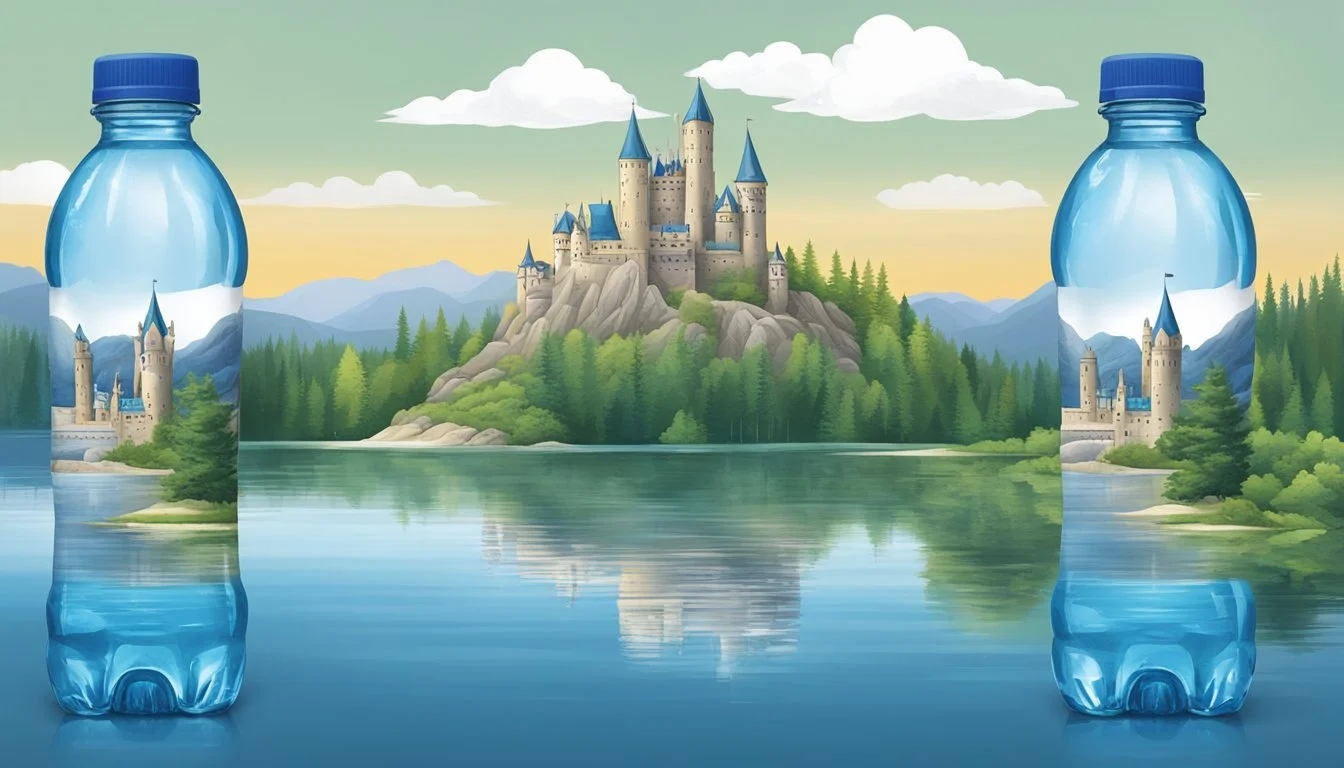Castle Rock vs. Open Water
An Unbiased Comparison of Bottled Water Brands
Choosing between Castle Rock and Open Water bottled waters can be a daunting task given the wide variety available today. Castle Rock Water boasts a crisp flavor akin to a refreshing hike in the mountains, and it is the only bottled water company globally that ensures fair dealings with natural resources. On the other hand, Open Water offers a reliable, pure taste without the plastic aftertaste, making it a preferred choice for many consumers.
Castle Rock Water completes a comprehensive purification cycle from the ocean to rain and glaciers, ultimately reaching the Shasta Spring where it is sourced and bottled in eco-friendly glass. Open Water is hailed for its purity and eco-conscious approach as well, using aluminum bottles that are easily recyclable. Both brands emphasize sustainability, but Castle Rock's natural spring water origin offers a distinct appeal.
For those seeking a knowledgeable comparison, Castle Rock's commitment to environmental stewardship and unique mountain spring source stands out. Meanwhile, Open Water’s modern approach with its recyclable packaging and clean taste attracts consumers looking for a straightforward hydration option. Ultimately, the best choice depends on the individual’s taste preferences and environmental values.
Exploring the Origin
Castle Rock and Open Water are distinguished by their specific origins and methods of extraction. Understanding their sourcing and differences between natural spring water and municipal water is crucial.
Source and Extraction
Castle Rock sources its water from the pristine Mount Shasta region in California. The water undergoes a natural purification cycle, flowing from ocean to rain, glacier, and finally to the Shasta Spring. This journey ensures a high purity level, contributing to its premium quality.
Open Water typically uses municipal sources, often treated tap water. This method involves extracting water from city supplies, followed by advanced filtration processes to ensure safety and improve taste. While convenient, municipal sources may lack the unique mineral profiles found in natural springs.
Natural Spring Water Vs. Municipal Water
Natural Spring Water, like Castle Rock, is renowned for its high mineral content and natural filtration process. It's sourced directly from the Earth, offering a pure and often refreshing taste profile. Consumers often prefer this type for its perceived health benefits and the natural origin.
Municipal Water, used by brands like Open Water, is derived from local water supplies. Although subjected to rigorous testing and purification, it may not offer the same mineral richness. This type of water is more accessible and environmentally friendly but may lack the distinct qualities of natural spring water.
Comparing these origins helps consumers make informed decisions based on their priorities, whether it's taste, mineral content, or environmental impact.
Health and Sustainability
When evaluating Castle Rock and Open Water, both health benefits and environmental impacts must be considered. Information on safety and quality reports also plays a crucial role.
Environmental Impact
Castle Rock claims to be the only bottled water company that fairly engages with natural resources. They emphasize sustainable practices and appropriate compensation for resource usage to help lower taxes and government funding. Open Water focuses on reducing plastic waste with their aluminum packaging, which is more recyclable and has a lower carbon footprint compared to traditional plastic bottles.
Comparison of Key Points:
Castle Rock: Emphasizes fair trading of natural resources, sustainable practices.
Open Water: Uses aluminum packaging, promotes recycling, and aims to reduce plastic pollution.
Health Benefits
Castle Rock markets its water as pure and beneficial, sourced from natural springs and rich in essential minerals. Their focus on natural sourcing can appeal to those looking for water with health-enhancing properties. Open Water, while also ensuring purity, emphasizes the removal of contaminants through rigorous filtering processes to provide clean and safe drinking water.
Key Health Attributes:
Castle Rock: Rich in minerals, sourced from natural springs.
Open Water: Highly filtered, focuses on purity and contaminant removal.
Safety and Quality Reports
Both Castle Rock and Open Water adhere to FDA regulations for bottled water, ensuring safety and quality. Castle Rock publishes quality reports that demonstrate adherence to safety standards and mineral content. Open Water equally maintains high safety standards, with frequent quality testing to uphold water purity and safety.
Safety and Quality Highlights:
Castle Rock: Regular quality reports, meets FDA and safety standards.
Open Water: Frequent quality testing, strict adherence to FDA regulations.
These considerations form the basis for evaluating health benefits and sustainability in bottled water choices.
Taste Profile
Both Castle Rock and Open Water offer distinctive taste profiles influenced by their sources and composition. Differing in flavor, aftertaste, and mineral content, each presents unique attributes for bottled water enthusiasts.
Flavor Factors
Castle Rock spring water is often praised for its crisp and clean taste. Sourced from Shasta Springs, this water carries a hint of natural minerals, contributing to a refreshing taste. Castle Rock carbonated options add a light effervescence that enhances its flavor profile without overpowering it.
Open Water, packaged in resealable aluminum bottles, focuses on a pure and neutral flavor. Known for its minimalistic taste, Open Water lacks the strong mineral presence found in other brands. This makes it a favorite for those who prefer a subtle, smooth drinking experience.
Water Sommelier Insights
According to water sommeliers, Castle Rock is often compared to a mountain stream. It has a slightly sweet undertone, likely deriving from its natural mineral content. The presence of minerals like calcium and magnesium not only enhances the taste but also lends a crisp finish.
Open Water is described as having an exceptionally smooth profile. Due to its careful filtration, it offers a clean and refreshing taste without any lingering aftertaste. This makes Open Water an excellent choice for pairing with food, as it doesn't dominate the palate.
Both brands have defined identities shaped by their source and processing techniques. While Castle Rock's carbonated options provide an added zing, Open Water's neutrality appeals to purists seeking the essence of water.
Packaging and Branding
Castle Rock and Open Water offer unique packaging solutions that highlight their commitment to quality and environmental sustainability. They use different materials and emphasize different aspects of their branding to attract consumers.
Plastic Versus Glass Bottles
Castle Rock Water Company predominantly uses glass bottles, specifically focusing on environmentally friendly glass. This choice underscores their emphasis on sustainability, as glass is highly recyclable and does not leach chemicals into the water, unlike plastic.
Open Water, on the other hand, uses aluminum bottles and cans. They claim aluminum is recycled more frequently than plastic and glass, offering a more sustainable option for consumers. Aluminum’s light weight compared to glass also means lower CO2 emissions during transportation.
While each material has its benefits, consumers seeking an eco-friendly choice might lean towards Castle Rock for its use of recycled glass or towards Open Water for their innovative aluminum packaging.
Labeling and Brand Perception
Castle Rock Water features a premium, artisanal look with elegant, minimalist labels that emphasize its origin and purity. Their branding often stresses the natural and high-quality source of their water, appealing to consumers who prioritize both luxury and environmental responsibility.
Open Water’s branding is more modern and utilitarian. Their labels highlight the company’s mission to clean up ocean plastic waste, with clear and vivid imagery. This approach resonates with eco-conscious consumers who are drawn to companies with a strong environmental mission.
The differing branding strategies of Castle Rock and Open Water showcase their unique commitments—one to luxury and purity, the other to sustainability and activism. Consumers’ preferences for one over the other will largely depend on their values and the messages they find most compelling.
Cost Comparison
When comparing Castle Rock and Open Water, examining the cost can provide insight into their market positioning. The prices vary based on whether each brand falls into the premium water or affordable choices categories, ultimately influencing consumers' decisions.
Premium Water Vs. Affordable Choices
Castle Rock positions itself as a premium water brand. Typically, premium waters like Castle Rock source from pristine locations, contributing to higher production costs. This ensures a clean, high-quality drinking experience, often commanding higher prices in the market.
In contrast, Open Water, often found in aluminum bottles, leans towards sustainability. While not always in the premium sector, its commitment to sustainability can mean a fairly priced product, but still higher compared to some inexpensive brands due to eco-friendly packaging costs.
Brand Price Category Unique Selling Point Castle Rock Premium High-quality, sourced from pristine areas Open Water Mid-Range Sustainable packaging
True Cost of Water
Comparing the true cost of bottled water involves assessing price per liter. Castle Rock may be more costly, reflecting its premium status. Open Water, while not as expensive, might still be priced above average due to its eco-friendly stance.
Healthline data suggests bottled water is significantly pricier than tap water—up to 2,000 times more. For example, while 1 gallon of tap water costs around $0.005, premium bottled water can exceed $9. Castle Rock falls into this high-cost category, while Open Water, though more affordable, still represents a higher cost due to sustainable packaging.
Water Type Average Cost per Gallon Tap Water $0.005 Premium Water $9.00+ Mid-Range Water $3.00 - $5.00
Market Overview
The bottled water market is diverse and growing, with numerous brands competing for consumer loyalty. Emerging trends focus on health benefits and environmental impacts.
Competing Brands Landscape
The bottled water market features a wide array of brands, each vying for a top position. Castle Rock and Open Water are part of a competitive landscape that includes heavyweights like Evian, Fiji, and Smartwater.
Castle Rock is renowned for its crisp, spring water taste, sourced from natural springs. On the other hand, Open Water markets its products in aluminum bottles, promoting sustainability.
Brands such as Evian and Fiji emphasize their premium status due to unique sources. Evian is sourced from the French Alps, while Fiji hails from an aquifer in Viti Levu in Fiji. Smartwater and Essentia highlight their reverse osmosis process, ensuring ultra-purified water. Competitive dynamics are further complicated by flavored and sparkling variants like San Pellegrino and Crystal Geyser.
Consumer Trends
Consumers are increasingly mindful of health and environmental impact, shaping purchasing decisions. Demand for hydration-focused products has resulted in the popularity of brands like Core Hydration and Essentia.
Eco-consciousness drives interest in alternatives such as Boxed Water and Open Water, which use more sustainable packaging. Meanwhile, health concerns boost the market for bottled water brands claiming purity and beneficial mineral content, such as LIFEWTR and Voss.
Trends indicate a growing preference for sparkling waters like San Pellegrino and Icelandic Glacial. Also, geographical preferences impact brands like Poland Spring and Ice Mountain in certain U.S. regions. The mix of these trends underscores an evolving landscape where brand differentiation and consumer priorities steer market direction.
Social Responsibility and Ethics
Castle Rock Water and Open Water both emphasize ethical practices in their business operations, focusing on corporate citizenship and transparency to build consumer trust. These companies strive to set themselves apart in the crowded bottled water market through their socially responsible initiatives.
Corporate Citizenship
Castle Rock Water has established itself as a leader in social responsibility within the bottled water industry. It holds the For Life - Social Responsibility certification and is proud to be the first bottled water in North America to obtain this credential. This certification recognizes a commitment to sustainable practices and fair labor conditions throughout their supply chain.
Additionally, the company emphasizes environmentally friendly policies, such as using recyclable materials. Castle Rock Water's headquarters in Dunsmuir, CA, showcases their dedication to environmental preservation and community support, contributing to local charities and initiatives regularly.
Similarly, Open Water emphasizes sustainability and social responsibility. Known for using aluminum packaging, which is more recyclable than plastic, they aim to reduce plastic waste. Open Water also supports clean water initiatives globally, investing in water projects to provide safe drinking water in underprivileged communities.
Transparency and Consumer Trust
Transparency plays a key role in how these companies maintain consumer trust. Castle Rock Water communicates openly about their sourcing and purification processes. Their website, www.castlerockwater.com, offers detailed information about the origins of their water and the standards they uphold. They also provide transparency reports and updates on their environmental impact.
Open Water also prioritizes transparency. They offer clear information on their sustainable practices and environmental impact. They regularly update consumers through their website and email newsletters, detailing their progress in reducing carbon footprints and improving recycling rates.
Both brands, Castle Rock Water and Open Water, recognize that transparency and consumer trust are essential for building a loyal customer base. By openly sharing their practices and goals, they aim to create a sense of accountability and engage customers in their mission for a more sustainable future.
Scientific Analysis
The scientific comparison between Castle Rock and Open Water involves examining their chemical composition and pH levels, which has implications for health and taste preferences.
Chemical Composition
Castle Rock water is sourced from a natural spring, which typically contains minerals like calcium, magnesium, and potassium. These minerals contribute to a balanced taste and are beneficial for health.
Open Water, on the other hand, is often sourced from municipal supplies and undergoes purification processes. This means it may have fewer natural minerals compared to spring-sourced alternatives.
Microplastics are a concern for both types, with studies showing that bottled water, regardless of the brand, can contain these particles originating from packaging. It's crucial to consider the naturally occurring minerals and potential contaminants when choosing bottled water.
pH Level and Alkalinity
The pH level measures how acidic or alkaline a water source is on a scale from 0 to 14. Castle Rock water often has a slightly alkaline pH, around 7.5 to 8.5. This alkalinity can be beneficial for counteracting acidity in the body, promoting better hydration and overall health.
Open Water usually aims for a neutral pH of around 7, but this can vary depending on the purification process and source. Water with a neutral pH is generally more suited for those who prefer a less pronounced taste.
Alkaline water is favored by some for its potential to neutralize acid in the bloodstream and improve hydration efficiency. On the other hand, neutral or slightly acidic water may be more effective at quenching thirst and delivering hydration more quickly.
Conclusion
When comparing Castle Rock and Open Water, several factors need to be considered.
Castle Rock, sourced from a mountain spring in Dunsmuir, provides a crisp flavor with no noticeable aftertaste. It stands out as a premium choice in the United States for its natural living water properties.
Open Water, meanwhile, often draws from municipal sources and is marketed as a convenient option. While it is widely available, it may not provide the same pure, natural taste as Castle Rock.
Key Differences:
Aspect Castle Rock Open Water Source Mountain Spring in Dunsmuir Municipal sources Flavor Crisp, clean Varies Availability Premium, selective distribution Widely available Environmental Impact Focus on fair resource usage Conventional
Castle Rock’s commitment to sustainability and resource fairness is noteworthy, indicating a more environmentally responsible approach.
On the other hand, Open Water's convenience and accessibility make it a popular choice among consumers.
Bottom line, if natural taste and environmental impact are critical, Castle Rock might be the better choice. For those prioritizing convenience and widespread availability, Open Water could be more suitable.
Evaluating these elements can help consumers decide which bottled water fits better with their life and lifestyle preferences.









